Building Economics - Construction Industry
Added on 2022-03-28
24 Pages5854 Words30 Views
Building Economics QS/
15/40/16
Acknowledgement
This research study embraces much dedication and ready assistance received from
many people, who contributed in plentiful ways to complete this study. Therefore, I take this
opportunity to convey my gratitude to every one of them.
First and foremost, I am indebted for my lecturer, Ms. Pabasara Kariyawasam for the
guidance given and for his constructive support throughout the period of study.
I would like to extend my grateful appreciation to the head of department BCAS and all other
academic and non-academic staff of the department of Building construction at British
College of Applied Studies, for their support so kindly given throughout finalizing this
dissertation successfully.
Also, I take this opportunity to thank my loving friends for their helps and advices. I owe
much appreciation to Ms. Pabasara Kariyawasam who supported me to sharpen my thinking
and backed me up in fulfilling this endeavor. Last but not least to all my family members for
providing me spiritual and emotional support.
15/40/16
Acknowledgement
This research study embraces much dedication and ready assistance received from
many people, who contributed in plentiful ways to complete this study. Therefore, I take this
opportunity to convey my gratitude to every one of them.
First and foremost, I am indebted for my lecturer, Ms. Pabasara Kariyawasam for the
guidance given and for his constructive support throughout the period of study.
I would like to extend my grateful appreciation to the head of department BCAS and all other
academic and non-academic staff of the department of Building construction at British
College of Applied Studies, for their support so kindly given throughout finalizing this
dissertation successfully.
Also, I take this opportunity to thank my loving friends for their helps and advices. I owe
much appreciation to Ms. Pabasara Kariyawasam who supported me to sharpen my thinking
and backed me up in fulfilling this endeavor. Last but not least to all my family members for
providing me spiritual and emotional support.
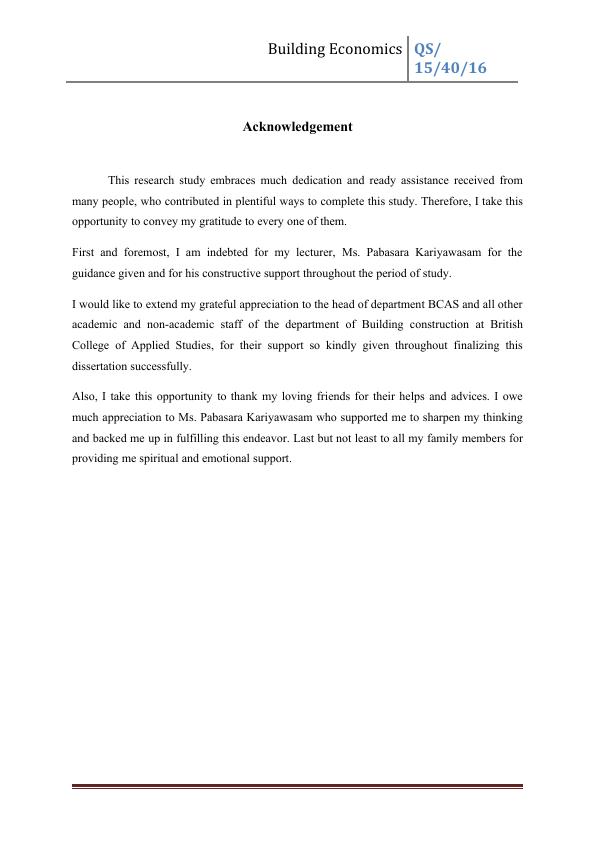
Building Economics QS/
15/40/16
Introduction
This is an assignment which is given by Ms. Pabasara Kariyawasam who is our lecturer of
Building Economics, for fourth semester in BTEC HND in Quantity Surveying. We are given
an assignment on Building Economics, which is the following modules have been explained
and also in this assignment scenario which is given in the assignment will be covered as
follows.
Stage of RIBA outline plan of work
Poster presentation
Cost planning
Types of cost planning
Post contract cost control function of Quantity Surveyor
This is an individual assignment which is completed by gathering information from
lecture notes, library books, and browsing. I hope, this assignment will provide the necessary
information of given assignment tasks, and those who read this assignment they can gain vast
knowledge on particular subject.
15/40/16
Introduction
This is an assignment which is given by Ms. Pabasara Kariyawasam who is our lecturer of
Building Economics, for fourth semester in BTEC HND in Quantity Surveying. We are given
an assignment on Building Economics, which is the following modules have been explained
and also in this assignment scenario which is given in the assignment will be covered as
follows.
Stage of RIBA outline plan of work
Poster presentation
Cost planning
Types of cost planning
Post contract cost control function of Quantity Surveyor
This is an individual assignment which is completed by gathering information from
lecture notes, library books, and browsing. I hope, this assignment will provide the necessary
information of given assignment tasks, and those who read this assignment they can gain vast
knowledge on particular subject.
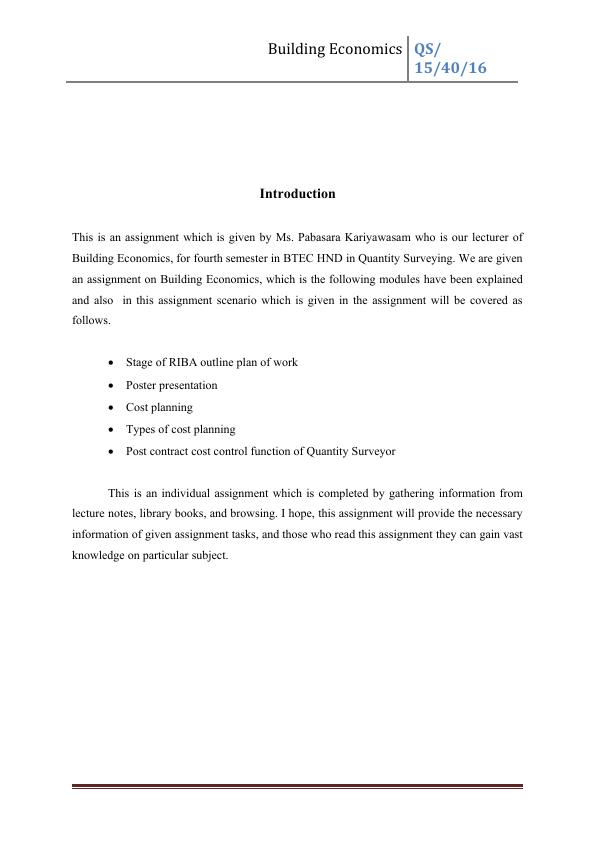
Building Economics QS/
15/40/16
Contents
Introduction...............................................................................................01
Acknowledgement .......................................................................................02
Contents...................................................................................................03
Task 01................................................................................................04-07
Task 02............................................................................................Poster 08
Task 03.............................................................................................Poster 09
Task 04................................................................................................10-13
Task 05.............................................................................................CRA 14
Task 06................................................................................................15-16
Task 07................................................................................................17-21
Conclusion................................................................................................22
Reference..................................................................................................23
15/40/16
Contents
Introduction...............................................................................................01
Acknowledgement .......................................................................................02
Contents...................................................................................................03
Task 01................................................................................................04-07
Task 02............................................................................................Poster 08
Task 03.............................................................................................Poster 09
Task 04................................................................................................10-13
Task 05.............................................................................................CRA 14
Task 06................................................................................................15-16
Task 07................................................................................................17-21
Conclusion................................................................................................22
Reference..................................................................................................23
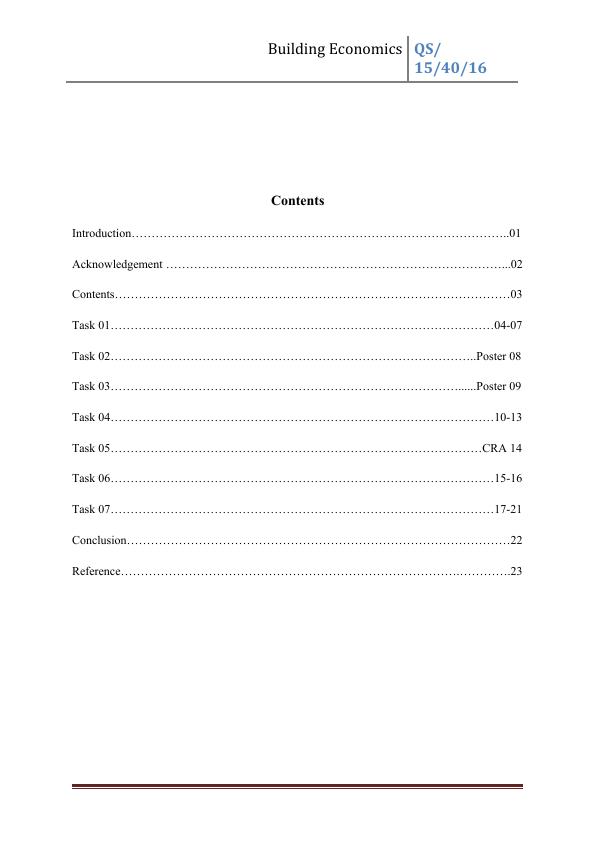
Building Economics QS/
15/40/16
Task 01
Due to the recent global recession, construction industry is a worst hit
industry worldwide. How has affected the Sri Lankan construction
industry? Which market segments were the most affected by this crisis?
Following points
- Construction industry is beneficial to the national economy
- Demand and supply is significant in residential market or commercial market
- Government intervention in construction industry is advantageous
- Construction business is cyclical in nature
Construction industry is beneficial to the national economy
Construction sector and construction activities are considered to be one of the major sources
of economic growth, development and economic activities. Construction and engineering
services industry play an important role in the economic uplift and development of the
country. It can be regarded as a mechanism of generating the employment and offering job
opportunities to millions of unskilled, semi-skilled and skilled work force. It also plays key
role in generating income in both formal and informal sector. It supplements the foreign
exchange earnings derived from trade in construction material and engineering services.
Construction plays a major role in the construction industry. Here, the buildings are the key
evidence of the growth of the country. Normally now a days the developed countries have
numerous buildings and significant architect works to express their development to the world.
Demand and supply is significant in residential market or
commercial market
Construction Industry is one of the most booming industries in the whole world. This
industry is mainly an urban based one which is concerned with preparation as well as
construction of real estate properties. The repairing of any existing building or making certain
alterations in the same also comes under Construction Industry.
15/40/16
Task 01
Due to the recent global recession, construction industry is a worst hit
industry worldwide. How has affected the Sri Lankan construction
industry? Which market segments were the most affected by this crisis?
Following points
- Construction industry is beneficial to the national economy
- Demand and supply is significant in residential market or commercial market
- Government intervention in construction industry is advantageous
- Construction business is cyclical in nature
Construction industry is beneficial to the national economy
Construction sector and construction activities are considered to be one of the major sources
of economic growth, development and economic activities. Construction and engineering
services industry play an important role in the economic uplift and development of the
country. It can be regarded as a mechanism of generating the employment and offering job
opportunities to millions of unskilled, semi-skilled and skilled work force. It also plays key
role in generating income in both formal and informal sector. It supplements the foreign
exchange earnings derived from trade in construction material and engineering services.
Construction plays a major role in the construction industry. Here, the buildings are the key
evidence of the growth of the country. Normally now a days the developed countries have
numerous buildings and significant architect works to express their development to the world.
Demand and supply is significant in residential market or
commercial market
Construction Industry is one of the most booming industries in the whole world. This
industry is mainly an urban based one which is concerned with preparation as well as
construction of real estate properties. The repairing of any existing building or making certain
alterations in the same also comes under Construction Industry.

Building Economics QS/
15/40/16
Demand in Construction Industry
Demand originates from different sub-sectors such as public housing, public-sector non-
housing, owner-occupied housing and private-sector industrial and commercial,
rehabilitation, improvements, repair and maintenance. However, only housing, industrial and
infrastructure sectors largely contribute to the construction output in Sri Lanka. It is therefore
in this light that output in those sub sectors are analyzed to review the trend of construction
Government policies will be the key deterministic factor in construction demand.
The government also offered incentives to promote private investment and this led to
a considerable increase in investment in industrial, commercial and shopping
complexes.
With respect to the private sector industrial and commercial buildings a significant
derived demand emerged with the establishment of Free Trade Zones, (an area for
investment by expatriate businesses with government incentive)
Private and foreign capital was boosted through the provision of incentives and
infrastructure support. This change led the construction sector to grow at a much
faster rate of 14.3% at peak of the public sector investment, which coincided with
private sector investment in commercial and industrial buildings.
The emergence of private property development companies made a considerable
impact on construction demand in this sector, particularly in urban areas where
demand grew rapidly with the expansion of the urban population. As a result,
condominium style apartments and pre-built luxury housing schemes were built in
urban/suburban areas.
The cost of construction, land supply and available sources of finance, project
delivery systems had a direct bearing on the demand in this sector.
Supply in construction industry
15/40/16
Demand in Construction Industry
Demand originates from different sub-sectors such as public housing, public-sector non-
housing, owner-occupied housing and private-sector industrial and commercial,
rehabilitation, improvements, repair and maintenance. However, only housing, industrial and
infrastructure sectors largely contribute to the construction output in Sri Lanka. It is therefore
in this light that output in those sub sectors are analyzed to review the trend of construction
Government policies will be the key deterministic factor in construction demand.
The government also offered incentives to promote private investment and this led to
a considerable increase in investment in industrial, commercial and shopping
complexes.
With respect to the private sector industrial and commercial buildings a significant
derived demand emerged with the establishment of Free Trade Zones, (an area for
investment by expatriate businesses with government incentive)
Private and foreign capital was boosted through the provision of incentives and
infrastructure support. This change led the construction sector to grow at a much
faster rate of 14.3% at peak of the public sector investment, which coincided with
private sector investment in commercial and industrial buildings.
The emergence of private property development companies made a considerable
impact on construction demand in this sector, particularly in urban areas where
demand grew rapidly with the expansion of the urban population. As a result,
condominium style apartments and pre-built luxury housing schemes were built in
urban/suburban areas.
The cost of construction, land supply and available sources of finance, project
delivery systems had a direct bearing on the demand in this sector.
Supply in construction industry
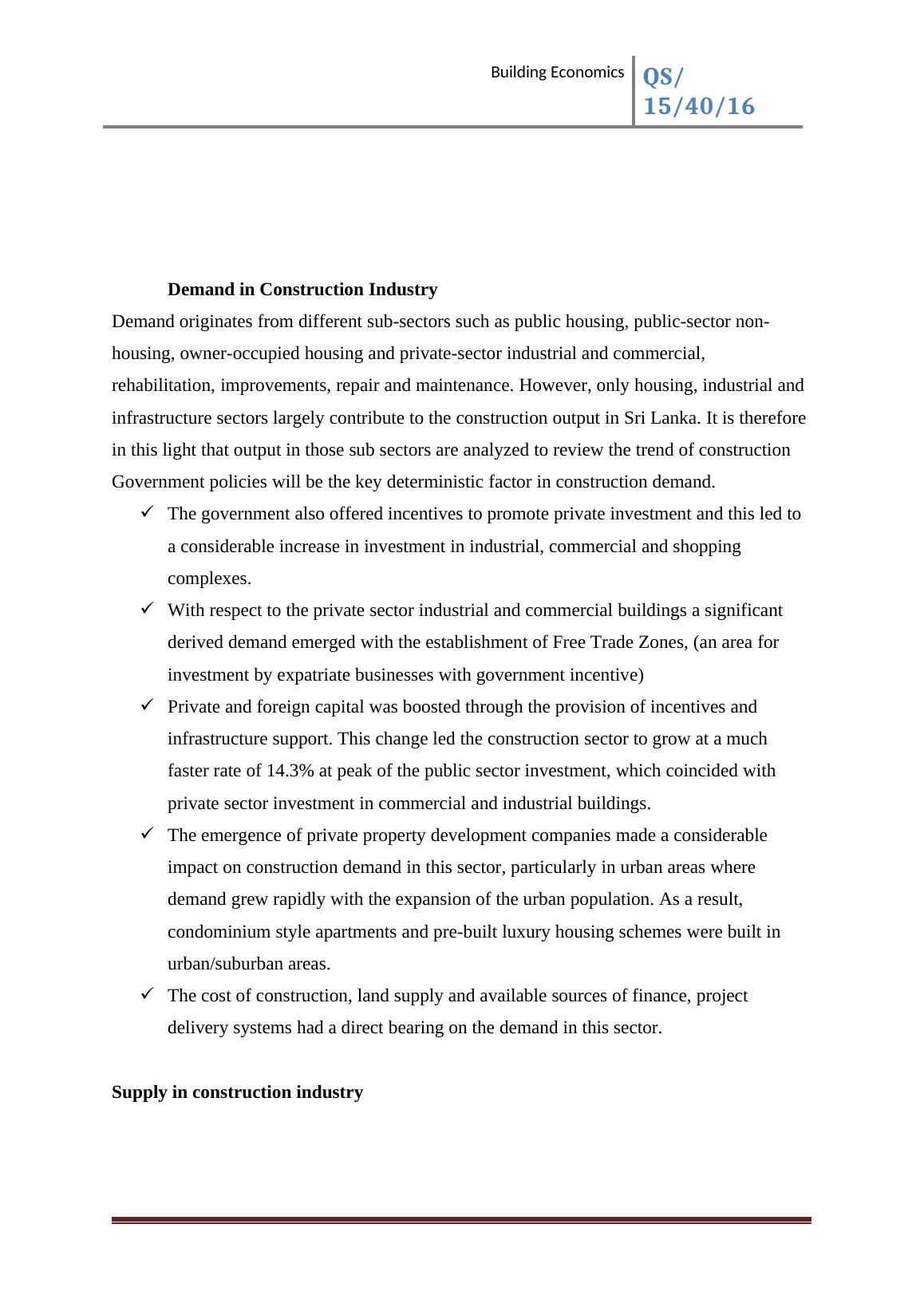
Building Economics QS/
15/40/16
The operation and behavior of the construction firm, price determination for
construction projects, the design process and the forecasting of construction prices
reflect the supply side of the construction industry.
Sub-contracting practices, sourcing of materials; labor and plant are of vital
importance to the construction output in the industry.
There are smaller firms in the industry and only 8% of the contractors are capable of
undertaking projects worth above SLR 10 million. This is one of the major reasons for
the greater share of donor-assisted projects being carried out by expatriate contractors.
Contractors have moved away from labor-intensive construction methods to the use of
capital-intensive operations such as the use of prefabrication systems, and ready
mixed concrete in high-rise buildings. This trend has been prompted by the demand
for private housing commercial and industrial building
In terms of project procurement, both the private and public sector clients widely
followed the traditional procurement systems
Government intervention in construction industry is advantageous
There are changes in economy can be done to regulate construction industry during boom and
recession period. When we take the boom period, in the boom period the demand will
increase. Due to demand increase the supply also increase parellaly. According to the
increase of the demand and supply employment also increases. So there will be lot of
employment. Here we have to consider important factor which is when demand and supply
increase the prices for the product also increase. In this situation the government involvement
will be there. Government will analysis the rate for the product and provides the restriction
for the prices of the loans. The government will use the fiscal policies like tax and increase
the interest for the product. This is the method that the government uses to balance the
economy in the boom period.
When we take the recession period, in the recession period the demand will decrease.
Due to demand decrease the supply also decrease parellaly. According to the decrease
of the demand and supply employment also decreases. So there will be unemployment
or idling of resources. Here we have to consider important factor which is when
15/40/16
The operation and behavior of the construction firm, price determination for
construction projects, the design process and the forecasting of construction prices
reflect the supply side of the construction industry.
Sub-contracting practices, sourcing of materials; labor and plant are of vital
importance to the construction output in the industry.
There are smaller firms in the industry and only 8% of the contractors are capable of
undertaking projects worth above SLR 10 million. This is one of the major reasons for
the greater share of donor-assisted projects being carried out by expatriate contractors.
Contractors have moved away from labor-intensive construction methods to the use of
capital-intensive operations such as the use of prefabrication systems, and ready
mixed concrete in high-rise buildings. This trend has been prompted by the demand
for private housing commercial and industrial building
In terms of project procurement, both the private and public sector clients widely
followed the traditional procurement systems
Government intervention in construction industry is advantageous
There are changes in economy can be done to regulate construction industry during boom and
recession period. When we take the boom period, in the boom period the demand will
increase. Due to demand increase the supply also increase parellaly. According to the
increase of the demand and supply employment also increases. So there will be lot of
employment. Here we have to consider important factor which is when demand and supply
increase the prices for the product also increase. In this situation the government involvement
will be there. Government will analysis the rate for the product and provides the restriction
for the prices of the loans. The government will use the fiscal policies like tax and increase
the interest for the product. This is the method that the government uses to balance the
economy in the boom period.
When we take the recession period, in the recession period the demand will decrease.
Due to demand decrease the supply also decrease parellaly. According to the decrease
of the demand and supply employment also decreases. So there will be unemployment
or idling of resources. Here we have to consider important factor which is when
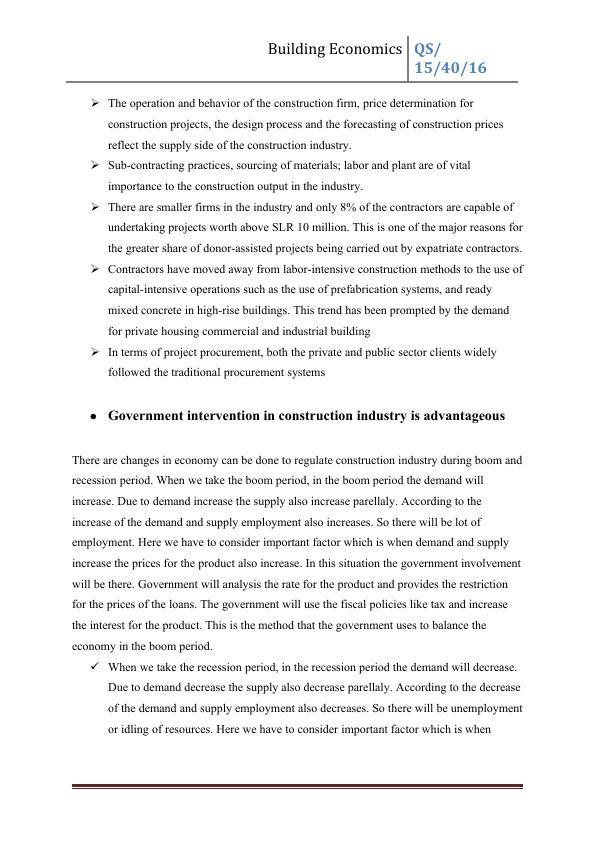
End of preview
Want to access all the pages? Upload your documents or become a member.
Related Documents
Law & Contractual Procedureslg...
|37
|11564
|61
Tender Estimation QS/15/40/16 Introductionlg...
|28
|4797
|171
HND in Quantity Surveying and Construction Economics | PDFlg...
|22
|5740
|340
Construction Technology Assignmentlg...
|43
|2083
|430
Management principals & application for constructionlg...
|62
|16783
|364
Sample of Industrial Training Report PDFlg...
|56
|11859
|3317